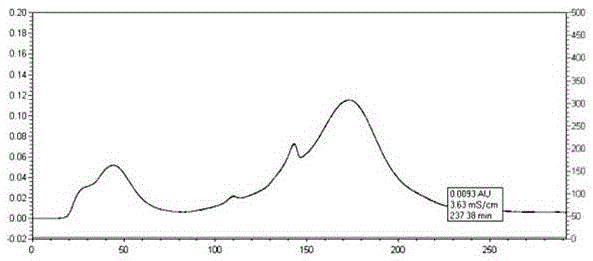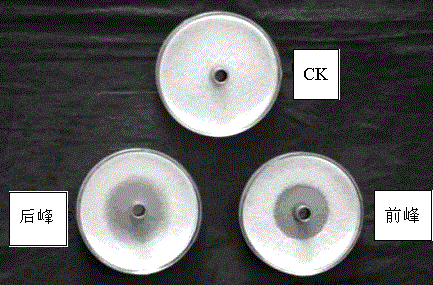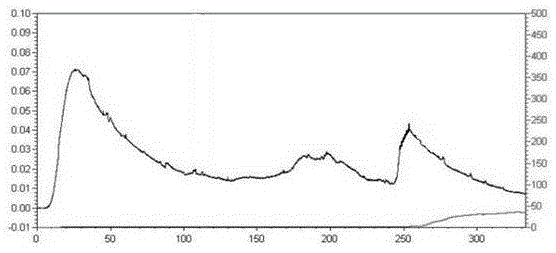A kind of antibacterial protein pbr1 and its preparation method and application
An antibacterial protein and aspect technology, applied in the fields of molecular biology and biological pesticides, can solve problems such as affecting human health and ecological balance, easily producing drug resistance, polluting the environment, etc., achieving good development prospects, remarkable control effects, and environmental protection. Effect
- Summary
- Abstract
- Description
- Claims
- Application Information
AI Technical Summary
Problems solved by technology
Method used
Image
Examples
Embodiment 1
[0037] Embodiment 1: Preparation and properties of the antibacterial protein PBR1 of the present invention
[0038] 1. Preparation of antibacterial protein PBR1
[0039] (1) Bacillus amyloliquefaciens (Bacillus amyloliquefaciens) XF1 strain CGMCC NO.2357 was inoculated in LB liquid medium, and cultured at 30° C. and 170 rpm for 48 hours with shaking to obtain a fermentation broth.
[0040] (2) separating and purifying the fermented liquid obtained in step (1) to obtain the target protein; the method for separating and purifying is:
[0041] ① Ammonium sulfate precipitation: take the fermented liquid obtained in step (1), centrifuge at 4°C for 10 minutes at 8000rpm, collect the supernatant, and use the salting-out method to add solid ammonium sulfate with 80% saturation to the fermented liquid, Precipitate for about 24 hours, then freeze and centrifuge at 12,000 rpm for 30 minutes to collect the precipitate.
[0042] ②Dialysis: Dissolve the precipitate collected in the step i...
Embodiment 2
[0061] Embodiment 2: the inhibitory effect of antimicrobial protein PBR1 to Plasmodium spore
[0062] The antibacterial protein PBR1 has a strong lytic effect on the spores of Plasmodium spores. After adding the antibacterial protein PBR1, it can be seen that the spores aggregate into chains or clusters ( Figure 6 B). After 6 hours, it can be seen that the cell wall of the Plasmodium spores is obviously thinner and the shape of the spores begins to become deformed ( Figure 6 C), after 24h, spore lysis has been seen, and the cell contents are extravasated ( Figure 6 D). However, the spores in the control (water, buffer solution) did not change ( Figure 7 ).
Embodiment 3
[0063] Embodiment 3: the mensuration of antibacterial protein PBR1 bacteriostatic spectrum
[0064] According to the inhibitory effect on 11 fungal strains, the isolated antibacterial protein PBR1 has a broad-spectrum inhibitory effect on pathogenic bacteria (see Table 1). It also has a good inhibitory effect on tomato cinerea, wheat take-all, and pomegranate wilt. These pathogens include Fusarium of the subphylum Deuteromycota, genus Ceratocystis of the subphylum Ascomycota, and genus Botrytis of the subphylum Deuteromycota.
[0065] Table 1 The antibacterial effect of antibacterial protein PBR1
[0066]
[0067] Note: +: antibacterial bandwidth ≥ 0.25cm: ++: antibacterial bandwidth ≥ 0.5cm;
[0068] +++ Antibacterial bandwidth ≥ 1cm; ++++ Antibacterial bandwidth ≥ 1.5cm.
[0069] Yunnan Agricultural University
[0070] An antibacterial protein PBR1 and its preparation method and application
[0071] /
[0072] 1
[0073] PatentInversion3.3
[0074] 1
...
PUM
| Property | Measurement | Unit |
|---|---|---|
| radius | aaaaa | aaaaa |
Abstract
Description
Claims
Application Information
 Login to View More
Login to View More - R&D
- Intellectual Property
- Life Sciences
- Materials
- Tech Scout
- Unparalleled Data Quality
- Higher Quality Content
- 60% Fewer Hallucinations
Browse by: Latest US Patents, China's latest patents, Technical Efficacy Thesaurus, Application Domain, Technology Topic, Popular Technical Reports.
© 2025 PatSnap. All rights reserved.Legal|Privacy policy|Modern Slavery Act Transparency Statement|Sitemap|About US| Contact US: help@patsnap.com



